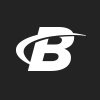Think back to the first time you lifted weights, there's a good chance that your first few exercises were either barbell curls or bench presses. It's almost inevitable that a young person's first inclination towards weights is to build a big chest and thick peaked arms. Unfortunately even those of us who strive for symmetry and aesthetic balance still hold that deep desire for a monstrous set of biceps - go on admit it!
Look at any arm training article and you will find an endless array of curls variations that promise to either thicken, peak or lengthen your biceps. Unfortunately some of these proposed benefits are physiologically impossible, but fret not as this article should explain how varying your curls can alter loading patterns and cause preferential recruitment of different elbow flexors that will help you build the set of arms you desire.
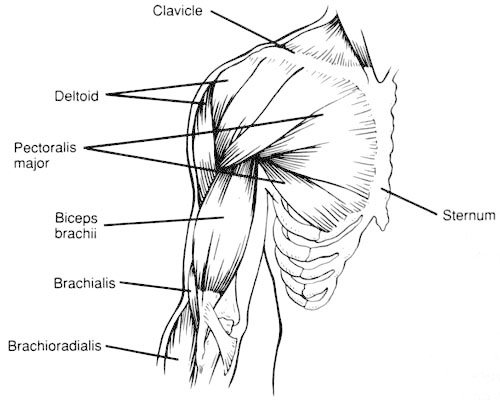
Several muscles make up the anterior part of the upper arm and aid in flexion of the elbow (bringing your hand closer to your shoulder).
The most recognisable muscle of the upper arm is the bicep brachii. The bicep muscle is what forms the ball like protrusion when you bend your elbow. Like its name suggests (Bi = two, Ceps = head) it contains two compartments, the long and the short head.
The long head originates up over the shoulder from the supraglenoid tubercle. The short head originates from the caracoid process and joins the long head to insert into the tuberosity of the radius (part of the forearm). The function of the bicep muscle is to flex (bend) the elbow as well as flex (raise) the arm at the shoulder and supinatation (turn palm up).
The second elbow flexor is the smaller brachialis which lies across the outer edge of the elbow and provides a visible contour between the muscles of the anterior and posterior upper arm. The brachialis originates from the anterior distal surface of the humerus and inserts into the tuberosity of the ulna.
The final elbow flexor is the brachioradialis whose bulk tends to form the forearm but still acts as an elbow flexor. The brachioradialis originates from the lateral epicondyle of the humerus (the bony lump on the outside of your elbow) and inserts at the lateral aspect of the styloid process of the radius.
All the muscles above aid in elbow flexion, but due to their anatomical positioning or physiochemical make up can be preferentially recruited to a greater or lesser degree. Considering this lets delve into the factors that alter loading and recruiting of the different elbow flexors.
Movement Variations & Preferential Recruitment
Shunt vs. Spurt
Muscles can be classified as either shunt or spurt muscles. A shunt muscle has its proximal attachment near the joint it acts over and its distal attachment at a greater distance away from the joint. As a shunt muscle contracts it applies force along the bones and pulls the joint surfaces together in order to stabilise the joint. The brachialis and brachioradialis are examples of shunt muscles.
The opposite can be said of spurt muscles, as their proximal attachment is away from the joint and its distal attachment is close. This enables the spurt muscle to apply force across the bone instead of along to create movement about the joint. Spurt muscles tend to be prime movers and the bicep brachii is classified as a spurt muscle.
Due to both biomechanical efficiency and there roles as shunt or spurt muscles, the biceps and brachialis are loaded and recruited differently at differing points in elbow flexion. During the outer range of the movement (arms virtually straight) the brachialis and brachioradialis are preferentially recruited. Conversely during the inner range of movement (arms bent) the bicep is preferentially recruited.
Considering this choosing an exercise that mechanically loads either the inner or outer range will effectively load either the biceps or brachialis and brachioradialis.
Angle Of Pull
To recruit any muscle effectively the resistance must be mechanically loading within the same direction as the fibres orientation. This means that as the muscle contracts it directly resists or overcomes the loading being placed upon it. For the elbow flexors this means altering the position of the hand through various degrees of pronation and supination.
For the biceps the optimal line of pull will be when there is near full supination (palms facing up), yet the bicep also has a secondary role as a supinating muscle, as such starting in a pronated position and supinating during the outer ranges activates the bicep but allows for the optimal line of pull of pronation during the biceps more effective inner range of motion.
The brachialis will have its fibres orientated optimally when the hand is in a semi pronated or neutral position (palms are facing each other). Lastly the brachioradialis has the best line of pull during full pronation (palms facing down).
Shoulder Positioning
The next factor worth considering is shoulder positioning. The next element only relates to the bicep brachii, but with increasing shoulder extension there becomes an ever increasing stretch upon the long head of the biceps which runs up over the shoulder and originates upon the supraglenoid tubercle.
With the increasing stretch there is a corresponding activation of the muscle spindles and a reflex activation of the stretched muscle.
Shoulder positioning is also one of the key determinates of mechanical loading to the outer range or inner range when the body remains upright. As the shoulder flexes the fulcrum (elbow) shifts forward allowing maximal mechanical loading in the outer range, as the leverage becomes maximal when the arm is straight. Shoulder extension allows the opposite with the fulcrum moving back and mechanical loading occurring greatest in the inner range of movement.
Speed Of Contraction
At this point you're probably thinking 'just tell me the exercises will ya!' Patients my fellow trainee, all in good time. The speed within which you perform your repetitions (rep cadence) will also affect recruitment. MRI studies have shown that during fast movements the bicep is preferentially recruited and conversely the brachialis has been shown to be recruited more during slow movements.
Several theories abound as to why this occurs; firstly it has been proposed that the pennation of the fibres are suited better for fast movements in the biceps due to its strap like configuration unlike the brachialis.
Secondly the fibre type compositions of the muscles could be different, with the brachialis being a shunt muscle and its role as a stabilisation muscle require more fatigue resistance and therefore a greater proportion of slow twitch fibres. In opposition the bicep is a prime mover and is proposed to be composed of a greater proportion of fast twitch fibres. Considering that the brachioradialis also acts as a shunt muscle it could be concluded the composition is similar.
TUT & Fiber Type Of Individual Muscles
Considering the above information if the brachialis and brachioradialis do contain a greater numbering of slow oxidative fibres, they will require a greater amount of time under tension (TUT - time during a set actually working) in order to exhaust the fibres and create a stimulus for growth. That said it would be a wise idea to train the biceps with heavy loads and fast movements in order to recruit and exhaust the fast fibres.
Complete Elbow Flexor Exercises
Ok, folks, now that we have got the dry theoretical stuff out of the way, we can crack on with the real business of dishing out the exercises.
Drag Curl:
First up is the drag curl. Hold onto a barbell shoulder width apart with a palm up (supinated) grip. Pull your elbows up and back so as the barbell is around navel height at the bottom of the curl and keep your elbows in this position throughout. As you perform the curl the bar should 'drag' up your chest.
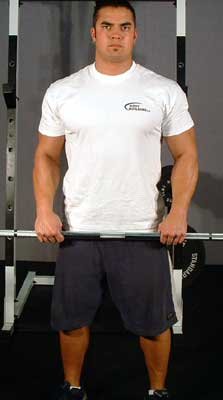
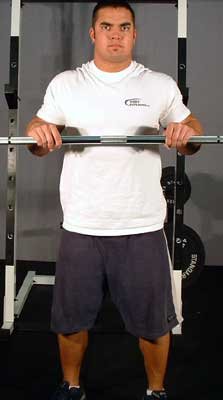
This insures the inner range of movement is loaded constantly. Perform four sets of four to six reps at a speed of two seconds for the lowering and a single second to lift it with no pause at the bottom position.
Incline Supinating Asymmetrical Curls:
After move on to incline supinating asymmetrical curls. This is performed by lying face up upon an incline bench set at around forty five degrees. Take hold of a set of dumbells but insure that your thumbs are up against the outside edge of the dumbell handles (i.e. there's no gap between thumb and weight edge). This forces the bicep to work against the weight in supination all the way through even when in fully supinated.
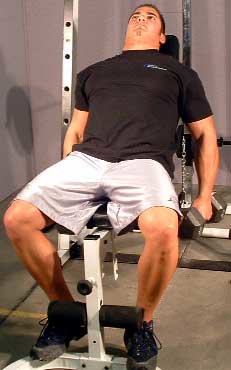
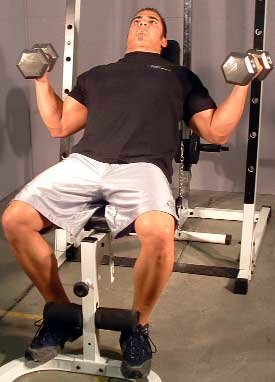
Start off with the palms facing down and as you curl rotate the dumbells up so your palms are facing up. Because you are lying on an incline and your arms are pulled back the long head will have a massive stretch. Perform four sets of four to six sets with a two seconds lowering, no pause and an explosive lifting phase as you curl.
Preacher Hammer Curls:
For the brachialis perform two sets of twelve to fifteen reps of the preacher hammer (palms facing each other) curl using dumbells. The preacher curl forces the load onto the outer range. Perform your reps with a three second lowering, pause for a second and take two seconds to lift the weight.
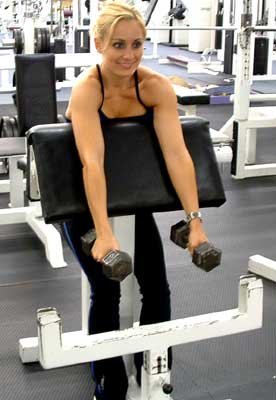
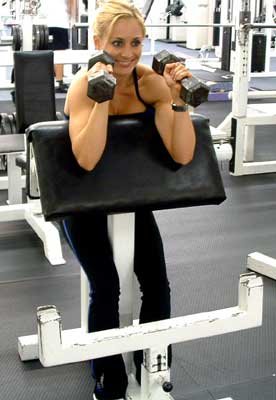
Two seconds lowering, no pause and an explosive lifting phase as you curl.
Preacher Reverse Curls:
Lastly perform a reverse (palms pronated) curl with a barbell on the preacher bench again.
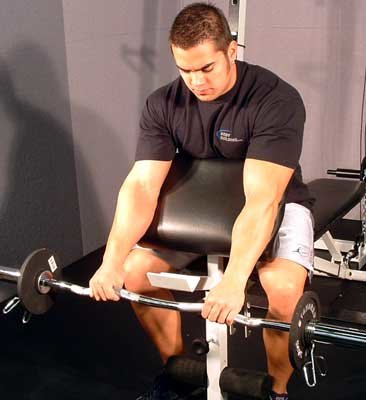
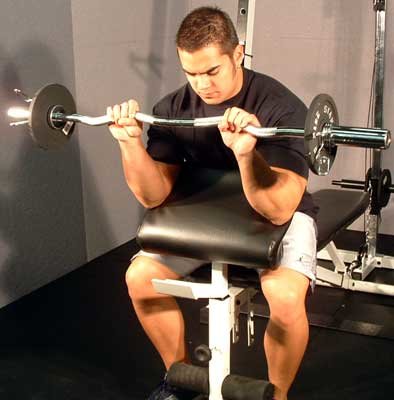
Perform your reps with a three second lowering, pause for a second and take two seconds to lift the weight.
Complete Elbow Flexor Routine
| Exercise | Reps | Sets | Rep Cadence |
| Drag Curls | 4-6 | 4 | 201 |
| Incline Asymmetrical Supinating Curls | 4-6 | 4 | 20X |
| Preacher Hammer Curls | 12-15 | 2 | 312 |
| Preacher Reverse Curls | 12-15 | 2 | 312 |
 Click Here For A Printable Log Of This Workout!
Click Here For A Printable Log Of This Workout!
Caveat
At this point I feel it should be said that the exercises above will greatly help development of any one of the elbow flexors mentioned.
However if your overall goals is to just add substantial mass to your arms, there can be no better choice of large compound movements (i.e. rows, pull ups, deadlifts and other pulling variations) combined with progressive overload and a surplus of calories for bolstering arm growth. It should also be noted that the triceps will play a huge role in helping to stretching out the measuring tape.
If your current arm program is stale or you need a substantial dose of arm development give the program above a try as a single training day devoted to curling or select one or more of the exercise to add into your current routine. Either way the monstrous set of biceps you desire should be close at hand.
